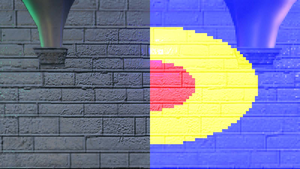Information
- Publication Type: Master Thesis
- Workgroup(s)/Project(s):
- Date: December 2019
- Date (Start): October 2018
- Date (End): December 2019
- TU Wien Library:
- Diploma Examination: 23. January 2020
- First Supervisor:
- Keywords: Variable Rate Shading
Abstract
With the NVIDIA Turing graphics card micro-architecture released in 2018, not only
performance in terms of operations per second is increased but also new hardware features
are introduced, like Variable Rate Shading (VRS). VRS allows focussing the processing
power by dividing the framebuffer into tiles and dynamically controlling the resolution of
each tile. To be precise, the screen is partitioned into tiles of 16x16 pixels and for each tile,
it can be specified how often the fragment shader shall be executed. It is both possible,
to have fewer fragment shader invocations than there are fragments, or more fragment
shader invocations than there are fragments. This allows individually defining lower
sampling rates or supersampling for regions of the screen. Regions of less interest or with
less visual details can be assigned less computational power in terms of shader executions
while regions that should provide high fidelity can be supersampled. The challenges here
are to find and distinguish these regions in a dynamic scene, like it is the case for games,
and how this technique integrates with commonly used techniques in the industry, like
deferred shading. NVIDIA already proposed some strategies on how these regions can
be distinguished and how the shading rate can be selected. Among these strategies are
Content-Adaptive Shading and Motion-Adaptive Shading. Content-Adaptive Shading
varies the shading rate according to the current content of a frame and does not take
temporal coherence into account. Motion-Adaptive Shading adapts the shading rate
according to the changes in the scene. Stable regions, like for example the horizon and
the car in a driving simulation, will be rendered with higher quality. In contrast, moving
regions like the street will be rendered more coarsely because the viewer cannot focus on
these regions anyway. Another approach for selecting the shading rate is to adapt the
resolution to the viewer’s focus. This can be done in combination with an eye-tracking
device and is called foveated rendering. We invented a novel approach that utilizes data
from temporal anti-aliasing techniques to detect under- and oversampled regions and
select the appropriate shading rate for these regions. We developed five algorithms,
edge-based and texel-differential based Content-Adaptive Shading, Motion-Adaptive
Shading integrating the motion over multiple frames, single-pass foveated rendering
and TAA-Adaptive Shading. The applicability of each algorithm to modern renderer
architectures with forward and deferred shading and anti-aliasing post-processing has
been evaluated. The major advantage of our VRS techniques is that some of them enable
up to 4x higher rendering resolution with the same performance or up to 4x better
performance at the same resolution.
Additional Files and Images
Additional images and videos
Additional files
Weblinks
No further information available.
BibTeX
@mastersthesis{stappen-2019-vrs,
title = "Improving Real-Time Rendering Quality and Efficiency using
Variable Rate Shading on Modern Hardware",
author = "Stefan Stappen",
year = "2019",
abstract = "With the NVIDIA Turing graphics card micro-architecture
released in 2018, not only performance in terms of
operations per second is increased but also new hardware
features are introduced, like Variable Rate Shading (VRS).
VRS allows focussing the processing power by dividing the
framebuffer into tiles and dynamically controlling the
resolution of each tile. To be precise, the screen is
partitioned into tiles of 16x16 pixels and for each tile, it
can be specified how often the fragment shader shall be
executed. It is both possible, to have fewer fragment shader
invocations than there are fragments, or more fragment
shader invocations than there are fragments. This allows
individually defining lower sampling rates or supersampling
for regions of the screen. Regions of less interest or with
less visual details can be assigned less computational power
in terms of shader executions while regions that should
provide high fidelity can be supersampled. The challenges
here are to find and distinguish these regions in a dynamic
scene, like it is the case for games, and how this technique
integrates with commonly used techniques in the industry,
like deferred shading. NVIDIA already proposed some
strategies on how these regions can be distinguished and how
the shading rate can be selected. Among these strategies are
Content-Adaptive Shading and Motion-Adaptive Shading.
Content-Adaptive Shading varies the shading rate according
to the current content of a frame and does not take temporal
coherence into account. Motion-Adaptive Shading adapts the
shading rate according to the changes in the scene. Stable
regions, like for example the horizon and the car in a
driving simulation, will be rendered with higher quality. In
contrast, moving regions like the street will be rendered
more coarsely because the viewer cannot focus on these
regions anyway. Another approach for selecting the shading
rate is to adapt the resolution to the viewer’s focus.
This can be done in combination with an eye-tracking device
and is called foveated rendering. We invented a novel
approach that utilizes data from temporal anti-aliasing
techniques to detect under- and oversampled regions and
select the appropriate shading rate for these regions. We
developed five algorithms, edge-based and texel-differential
based Content-Adaptive Shading, Motion-Adaptive Shading
integrating the motion over multiple frames, single-pass
foveated rendering and TAA-Adaptive Shading. The
applicability of each algorithm to modern renderer
architectures with forward and deferred shading and
anti-aliasing post-processing has been evaluated. The major
advantage of our VRS techniques is that some of them enable
up to 4x higher rendering resolution with the same
performance or up to 4x better performance at the same
resolution.",
month = dec,
address = "Favoritenstrasse 9-11/E193-02, A-1040 Vienna, Austria",
school = "Research Unit of Computer Graphics, Institute of Visual
Computing and Human-Centered Technology, Faculty of
Informatics, TU Wien",
keywords = "Variable Rate Shading",
URL = "https://www.cg.tuwien.ac.at/research/publications/2019/stappen-2019-vrs/",
}

 poster
poster thesis
thesis


